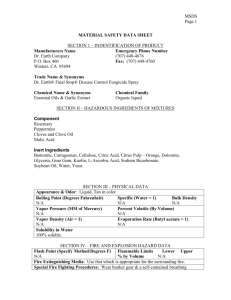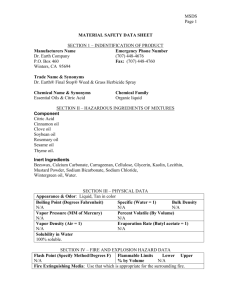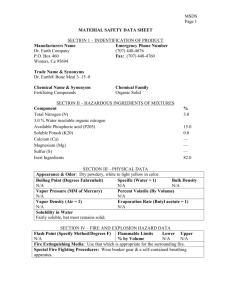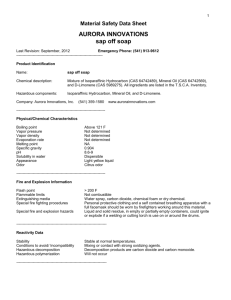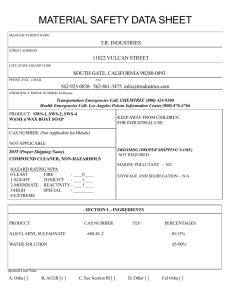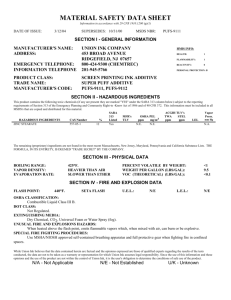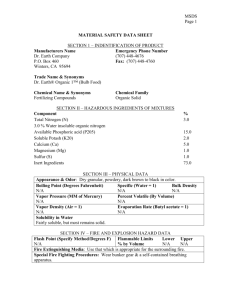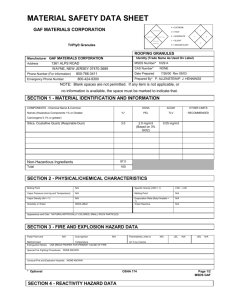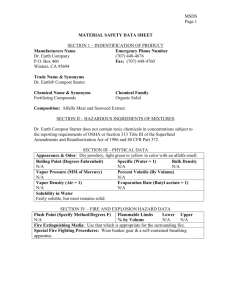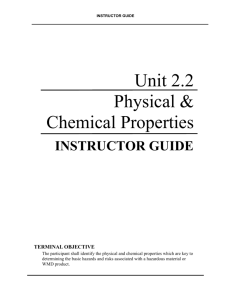Material Safety Data Sheet (MSDS) Activity
advertisement
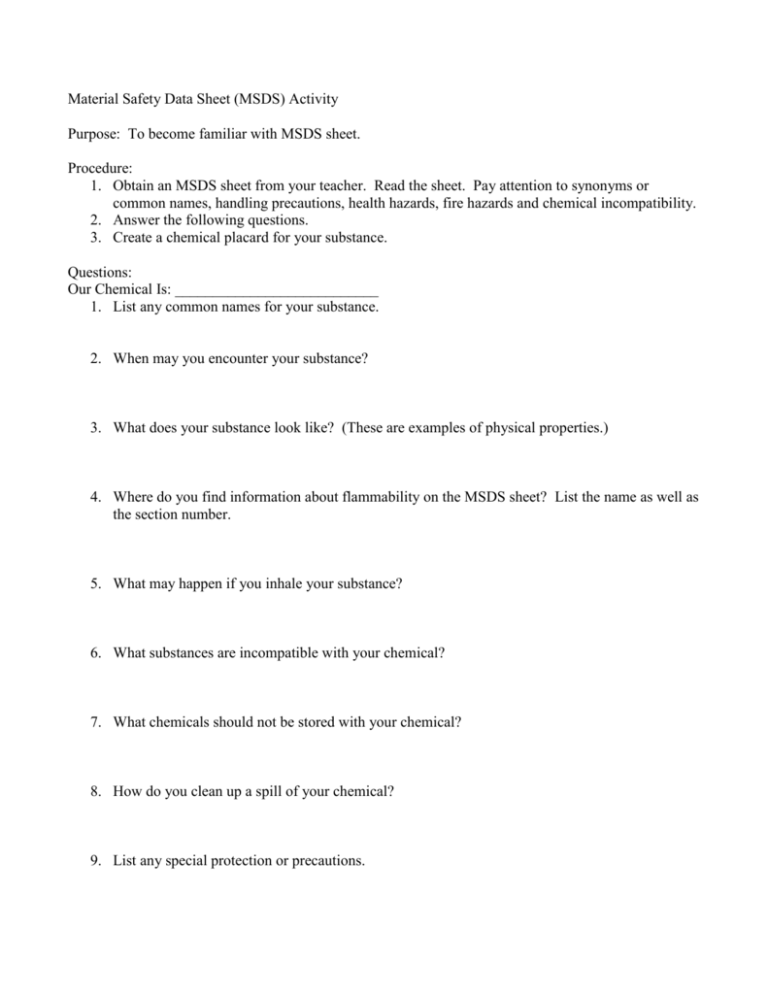
Material Safety Data Sheet (MSDS) Activity Purpose: To become familiar with MSDS sheet. Procedure: 1. Obtain an MSDS sheet from your teacher. Read the sheet. Pay attention to synonyms or common names, handling precautions, health hazards, fire hazards and chemical incompatibility. 2. Answer the following questions. 3. Create a chemical placard for your substance. Questions: Our Chemical Is: ___________________________ 1. List any common names for your substance. 2. When may you encounter your substance? 3. What does your substance look like? (These are examples of physical properties.) 4. Where do you find information about flammability on the MSDS sheet? List the name as well as the section number. 5. What may happen if you inhale your substance? 6. What substances are incompatible with your chemical? 7. What chemicals should not be stored with your chemical? 8. How do you clean up a spill of your chemical? 9. List any special protection or precautions. Section I - Product Identification: Manufacturer's Name: The manufacturer of the product is listed along with the manufacturer's address. Emergency Telephone Number: The telephone number of people other than the manufacturer who may provide information for a chemical emergency; a spill, explosion, fire, etc. Chemical Name and Synonyms: Chemical name of the material, if it is a single element or compound, along with other terms for the substance. Trade Name and Synonyms: The name the product is sold by along with other terms for the formulation. Chemical Family: General class of compounds to which a material belongs (e.g. ether, mineral acid, ketone, etc.). Formula: Formula for the number and types of atoms contained in the substance if it is a single element or compound. Section II - Hazardous Ingredient Information: Hazardous Ingredients: Listed by chemical name in one of three divisions (paints, preservatives and solvents; alloys and metallic coatings, or hazardous mixtures of other liquids, solids, or gases) unless the product is a bona fide trade secret. Percentage: Percent by weight or volume of each ingredient. PEL: Term used by the Occupational Safety and Health Administration (OSHA) to express the legal airborne concentration of a material to which persons can be exposed day after day. Usually stated in parts per million (ppm) or milligrams per cubic meter (mg/M3). TLV: Term used by the American Conference of Governmental Hygienists (ACGIH) to express the airborne concentration of a material to which nearly all persons can be exposed day after day, without adverse health effects. Section III - Physical Data: Boiling Point: Temperature at which a liquid changes to a vapor at a given pressure, usually stated in of at one atmosphere pressure. For mixtures, the initial boiling point or boiling range may be given. Vapor Pressure: Pressure exerted by a vapor above its own liquid in a closed container, usually stated in millimeters of mercury (mm of Hg) at 20oC (unless stated otherwise). Vapor Density: Relative density or weight of a vapor or gas compared to an equal volume of air. Air is rated as 1.0. Solubility in Water: The amount of a substance which can be dissolved in a given volume of water. Expressed usually in terms of milligrams per liter or in general terms such as "negligible." Appearance and Odor: Brief description of the substance at normal room temperature and atmospheric conditions (e.g. viscous, colorless liquid with an aromatic hydrocarbon odor). pH: An expression of the acidity or alkalinity of an aqueous solution by the logarithm of the reciprocal of the hydrogen ion concentration. Specific Gravity: Weight of a volume of substance to an equal volume of water. A ratio of less than one means the material is lighter than water and vise versa. Percent Volume by Weight: Percent of a liquid or solid (by volume) that will evaporate at an ambient temperature of 70oF. Evaporation Rate: Rate at which a material is converted to the vapor state at any given temperature and pressure. Section IV - Fire and Explosion Hazard Data: Flash Point and Method Used: Lowest temperature at which a liquid will give off enough flammable vapor to ignite. Flammable Limits: Range of concentrations over which a flammable vapor mixed with air will flash or explode if an ignition source is present. Extinguishing Media: Fire-fighting material for use on substance that is burning, Fire-fighting material should be indicated by its generic name (e.g. water, foam, dry chemical, etc.). Special Fire Fighting Procedures and Precautions: Listing of certain fire-fighting materials unsuitable or unsafe to use on the burning substance. Also, a listing of special handling procedures and personal protective equipment. Unusual Fire and Explosion Hazards: Hazards which might occur from overheating or burning of substance, including any chemical reactions or changes in chemical form or composition. Also, any special hazards which may need to be considered while extinguishing a fire. Section V - Health Hazard Data: Threshold Limit Value: Explained previously in Section II. Effects of Overexposure: Covers immediate (acute) and long-term (chronic) effects of overexposure to the substance. May include information from human experience and animal tests. Toxicity data may also be provided in the form of average lethal dose or concentration (LD50 or LC50, respectively). Emergency and First-Aid Procedures: Emergency information and first aid instructions for treatment of acute inhalation, ingestion, and skin or eye contact. Section VI - Reactivity Data: Stability: Indication of whether the substance is susceptible to dangerous decomposition and under what conditions it might occur. Conditions to Avoid: Conditions which may cause hazardous consequences or damage to the substance (e.g. heat, shock, cold, light). Incompatibility: Common materials or contaminants with which the specific substance may come in contact and release large amounts of energy, flammable vapor or gas, or produce toxic vapor or gas. Hazardous Decomposition Products: Hazardous materials that may be produced in dangerous amounts if the substance is exposed to burning, oxidation, heating or allowed to react with other chemicals. Hazardous Polymerization: Polymerization is a chemical reaction in which two or more small molecules combine to form larger molecules that contain repeating structural units of the original molecules. A hazardous polymerization is an unintended and uncontrolled polymerization reaction that may create a great deal of heat and may release a hazardous substance. Section VII - Spill or Leak Procedures: Spill and Leak Procedures: Immediate steps to be taken to assure safety to people and property in the event of a spill or leak of the substance including equipment and personal protective equipment. Methods for control and clean-up are described. Waste Disposal Method: May describe a method for disposing of excess, used, or spilled material. Section VIII - Special Protection Information: Respiratory Protection: Requirements for respiratory protection should ventilation recommendations not be feasible. Ventilation: Type of ventilation, if needed when working with the substance. Protective Gloves: The appropriate gloves, if needed, to prevent hand contact (e.g. rubber, vinyl, neoprene). Eye Protection: Type of eye protection device to be worn when working with the substance. Other Protective Equipment: Additional protective measures or equipment recommended when working with the substance (e.g. apron, boots, glove box) Section IX - Special Precautions: Precautions to be Taken in Handling and Storage and Other Precautions: Describes additional precautions to be considered or may give special emphasis to information or warning stated in other sections of MSDS.
